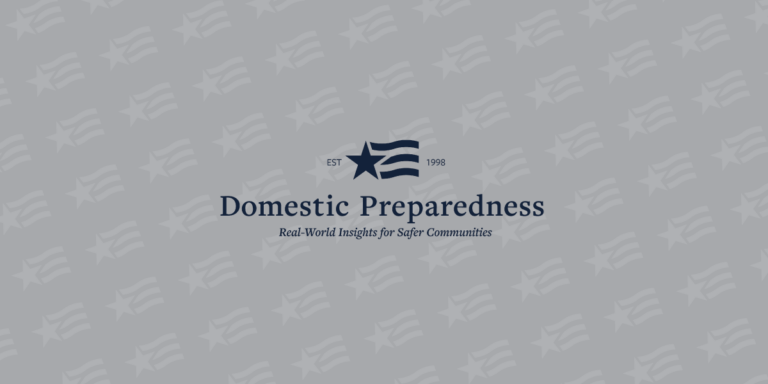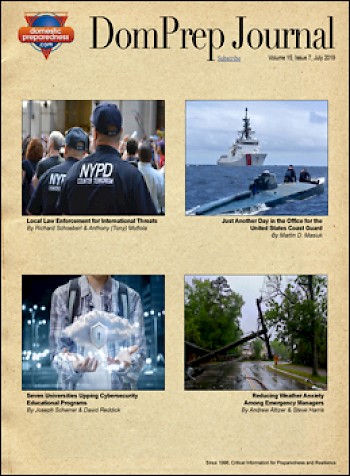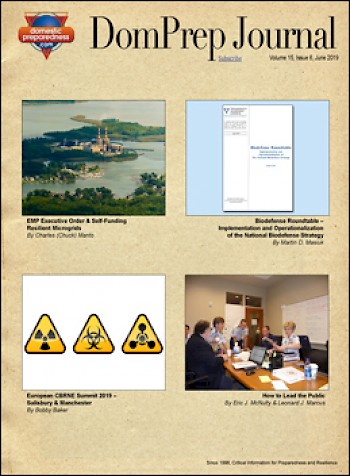
Author Archive

The 2019 National Threat and Hazard Identification and Risk Assessment (THIRA): Overview and Methodology provides an in-depth description of the Federal Emergency Management Agency’s (FEMA) approach to completing a national-level risk assessment. The intended audience is emergency management officials engaged in risk assessment at the community and federal levels, as

Mental Health Issues and Conditions in Children and Youth Exposed to Human-Caused Disasters
Domestic Preparedness
August 3, 2019
This bulletin focuses on mental health and substance use issues and conditions in children and youth after human-caused disasters, such as oil spills, radiation disasters, public health emergencies, incidents of mass violence, and terrorism. https://www.samhsa.gov/sites/default/files/mental-health-substance-use-issues-exposed-youth.pdf

July 2019
Domestic Preparedness
July 31, 2019
Featured in this issue: Combating Threats – Both Domestic & Global, , By Catherine L. Feinman; Local Law Enforcement for International Threats, By Richard Schoeberl & Anthony (Tony) Mottola; Just Another Day in the Office for the United States Coast Guard, By Martin D. Masiuk; Seven Universities Upping Cybersecurity Educational

Mass Casualty Trauma Triage – Paradigms and Pitfalls
Domestic Preparedness
July 18, 2019
This document contains planning considerations that emergency medical services (EMS) medical directors, EMS systems planners, and hospital emergency planners should review when developing mass casualty incident plans and training programs. The focus of this paper is specifically designed to educate emergency planners on the key distinctions of no-notice, dynamic incident scenes

Mass Attacks in Public Spaces – 2018
Domestic Preparedness
July 16, 2019
In response to the acts of targeted violence occurring in the United States, the U.S. Secret Service National Threat Assessment Center (NTAC) has published this research report. The study was conducted for the specific purpose of identifying key information that will enhance efforts to prevent these types of attacks, building on the

Radiological Dispersal Device (RDD) Response Guidance – Planning for the First 100 Minutes
Domestic Preparedness
July 15, 2019
This document and accompanying video provides actionable guidance, sample text for a radiological dispersal device (RDD) response protocol, and annexed tools that can be used for local planning of an effective response to an RDD to protect first responders and the general public, and establish interagency coordination and integration of

The U.S. Department of Defense’s Role in Health Security
Domestic Preparedness
July 12, 2019
The Department of Defense contributes to overall U.S. health security through programs specifically aimed at countering biological threats from all sources. Public health activities are coordinated with civilian counterparts at home and abroad and through research and development of medical countermeasures aimed at protecting U.S. forces against health risks throughout the world.

Mass Casualty Incident Response Toolkit
Domestic Preparedness
July 9, 2019
Mass casualty incident (MCI) response is a critical focus area for the Greater New York Hospital Association (GNYHA) and its member hospitals. Over the past several years, GNYHA has led collaborative planning efforts related to MCI response in coordination with government response agencies and the health care community, resulting in

June 2019
Domestic Preparedness
June 26, 2019
Featured in this issue: The Enterprise That Guards Against Attack, By Catherine L. Feinman; EMP Executive Order & Self-Funding Resilient Microgrids, By Charles (Chuck) Manto; Biodefense Roundtable – Implementation and Operationalization of the National Biodefense Strategy, By Martin D. Masiuk; How to Lead the Public, By Eric J. McNulty &

Preparedness Leadership Council (PLC) Biodefense Roundtable – Implementation and Operationalization of the National Biodefense Strategy
Domestic Preparedness
June 19, 2019
The National Biodefense Strategy highlights President Donald Trump’s commitment to protect the American people, “and establishes objectives to effectively counter threats from naturally occurring, accidental, and deliberate biological events.” This strategy is intended to guide innovation and collaboration beyond the federal government. The president is targeting this strategy for action by state,
Follow Us
Get Instant Access
Subscribe today to Domestic Preparedness and get real-world insights for safer communities.
ARchives
Article Out Loud – Avoiding the Complacency Trap After This Hurricane Season
November 23, 2022
Despite punishing hurricanes in Puerto Rico and Florida, the 2022 season has been relatively quiet for much of the Gulf coast and Atlantic seaboard. This article describes the resources that help communities mitigate risk now before the next hurricane season.
Article Out Loud – PPD-44: Implications for Domestic Incident Management
November 23, 2022
An essential national incident management guidance document is finally available to responders nationwide. This document will significantly improve a unified response to and recovery from large-scale incidents. However, additional work is needed to create an enhanced unity of effort and fully integrated response among federal, state, and local responders.
Article Out Loud – Public Works Emergency Management – From Training to Reality
November 22, 2022
For understandable reasons, major disasters – e.g., earthquakes and tsunamis – get most of the headlines and more of the public funds available even in economically difficult times. Local jurisdictions would be well advised, therefore, not only to focus greater attention on emergencies closer to home but also to ask
Article Out Loud – Critical Infrastructure & Strategic Assessment
November 22, 2022
Globally, government agencies are at a nexus in how to plan for and address society’s dependence on infrastructure to sustain economies, support and protect people, and implement strategies to provide for an appropriate level of reinvestment. Partnerships with the private financial world would help develop an effective framework for investments
Article Out Loud – Workplace Strategies to Reduce Burnout and Build Resilience
November 16, 2022
A multi-year pandemic has resulted in organizations looking to reframe traditional workforce management practices to retain seasoned staff and prevent burnout. To address these issues, state, local, tribal, and territorial emergency management offices can consider implementing workplace engagement strategies to address the mental and physical health concerns resulting from this
Article Out Loud – Switch to Online Enables New Active Shooter Training for All
November 16, 2022
Since the emergence of COVID-19, many trainings have had to adapt to an online presence. In one case, an active shooter training not only successfully transitioned to support the online delivery of these skills, but the developer embraced it and has now made it publicly available for everyone.
Article Out Loud – A Global Sensor Network for Disaster Warnings
November 15, 2022
Technology and sensor innovation must be interoperable across jurisdictions. Look how much global sensor networks for disaster warnings have evolved internationally since 2009.
Article Out Loud – National Preparedness: Challenges, Definitions & Jurisdictions
November 15, 2022
Change is often accompanied by challenges. This article shares the challenges that state and local jurisdictions faced in 2013 as they began implementing the guidance provided by Presidential Directive 8.
Article Out Loud – Power Outages, Communication Failures & Healthcare
November 9, 2022
After-action reviews highlight the successes and expose the failures of disaster preparedness and response efforts. Four significant events demonstrate how communities managed when power outages, communication failures, and healthcare concerns emerged in their aftermath.
Article Out Loud – The Role of Faith in Disasters
November 9, 2022
Many faith-based organizations have disaster response and recovery components as major elements of their own missions. By partnering with governmental and nongovernmental organizations, faith-based groups can coordinate locally to support response and restoration efforts, as well as provide mental health and spiritual care when resources are critically needed.
Follow Us
Get Instant Access
Subscribe today to Domestic Preparedness and get real-world insights for safer communities.


